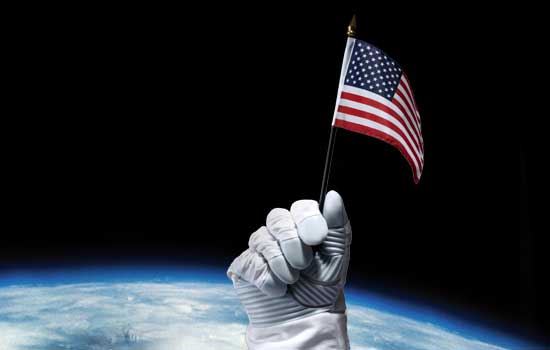 This past weekend, China became the third country to land a spacecraft intact on the moon. The unmanned Chang’e-3 probe subsequently deployed a robot rover that will explore the lunar surface for the next three months, while the landing vehicle will conduct scientific experiments for the coming year. Beijing’s accomplishment is notable since it was the first time it attempted such a maneuver and the event is an important milestone for Beijing’s aspiring space program.
This past weekend, China became the third country to land a spacecraft intact on the moon. The unmanned Chang’e-3 probe subsequently deployed a robot rover that will explore the lunar surface for the next three months, while the landing vehicle will conduct scientific experiments for the coming year. Beijing’s accomplishment is notable since it was the first time it attempted such a maneuver and the event is an important milestone for Beijing’s aspiring space program.
It’s also being hailed by many in China as a major display of national power. Referring to the political slogan introduced by Xi Jinping, China’s new leader, the Xinhua news agency exclaimed that “the dream for lunar exploration once again lights up the China Dream.” Another state-run news agency, sounding a bit like North Korean propaganda, even crowed that “the whole world again marvels at China’s remarkable space capabilities…”
But the hoopla coming out of China is overblown on several counts. First, the success of the Chang’e-3 comes 41 years after the Apollo 17 mission delivered two astronauts and a rover vehicle on the moon (December 1972) and 37 years after the last unmanned probe landing by the Soviet Union (August 1976).
Second, it elides over the interplanetary efforts by India, China’s rival in the space race that is shaping up in Asia (see here and here for more background). Six weeks ago, New Delhi launched a probe that is scheduled to reach Mars orbit next September after a 420 million-mile journey. If all goes according to plan, India will become the first Asian country and the fourth in the world to reach the Red Planet. Two years ago, a Chinese probe destined for Mars failed to leave Earth’s orbit when its Russian launch vehicle malfunctioned; the probe eventually crashed into the Pacific Ocean.
Finally, it’s the United States that remains the country pioneering the final frontier. I’ve noted in an earlier post how the U.S. private entrepreneurs are inaugurating a new era in space transportation, taking on tasks that were heretofore the province of national governments. No other company better illustrates this development than the Space Exploration Technologies Corporation, established by Elon Musk, PayPal’s co-founder and the inspiration for the character of genius billionaire/superhero Tony Stark in the Iron Man movie series.
Three years ago, SpaceX became the first private company to launch and return a spacecraft from orbit. Then, in May 2012, it began carrying supplies to and from the International Space Station (ISS), filling the void left by cutbacks in the U.S. manned-space program and demonstrating a capability to do what no national government currently can do: deliver and bring back to Earth significant amounts of cargo from orbital platforms.
And two more recent exploits demonstrate how SpaceX remains at the forefront. In September, after deploying a small satellite in orbit, a SpaceX rocket performed an unprecedented maneuver by re-entering the earth’s atmosphere at hypersonic speed without burning up. The plan for a controlled descent to the Pacific Ocean went awry, however, when the vehicle spun out of control and fragmented upon hitting the water. But SpaceX is confident that it can perfect its design for reusable rocket engines and plans to try again in February during its next cargo run to the ISS.
And earlier this month, SpaceX ventured beyond low-Earth orbit to place a communications satellite into geosynchronous orbit – approximately 22,000 miles above the Earth — for a fraction of the going market rate. This is the first time that a privately-built launch vehicle has delivered a private commercial satellite into orbit. According to the Wall Street Journal, the deployment credibly establishes SpaceX “as a low-cost alternative to legacy satellite-launch providers backed by U.S. and foreign governments.” In recognition of the company’s successes, NASA last week announced that it is leasing iconic Launch Pad 39A at the Kennedy Space Center in Florida to the firm. SpaceX currently has a backlog of more than 50 missions for NASA and commercial customers, including 10 cargo runs for the ISS.
Beyond just hauling around cargo, SpaceX, along with another start-up called Blue Origin and run by Amazon.com co-founder Jeff Bezos, is in the running for NASA contracts to send humans into space. A Silicon Valley-based startup called Moon Express plans to send a landing vehicle to the moon in late 2015, with the long-term objective of mining resources. A new company, called Planetary Resources, has announced plans to extract minerals from asteroids. Co-founded by Peter Diamandis, the impresario behind the X Prize, the firm has received investment capital from Google executive chairman Eric Schmidt and co-founder Larry Page, as well as James Cameron, the Hollywood director and explorer.
The expanding U.S. commercial space industry illuminates a strategic trend that underscores America’s staying power but which tends to get lost in the hype about China: How private-sector dynamism is supplementing and in some cases supplanting governmental efforts to push forward the frontiers of science, technology and imagination. As The Economist puts it, “China is busy re-living the past for much the same reasons that America and the Soviet Union lived it the first time round. [But] the future lies elsewhere.”
This commentary is cross-posted on Monsters Abroad. I invite you to connect with me via Facebook and Twitter.